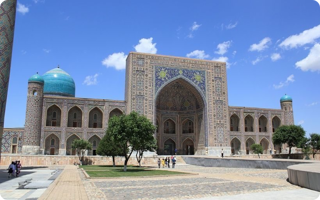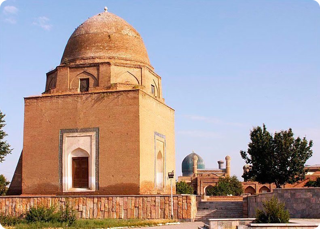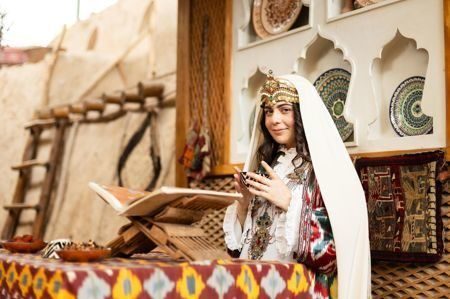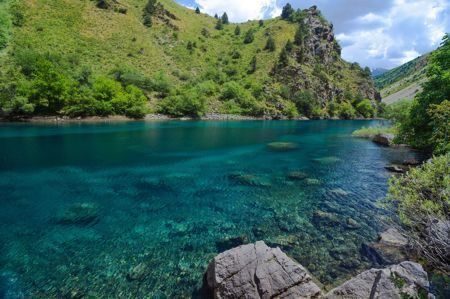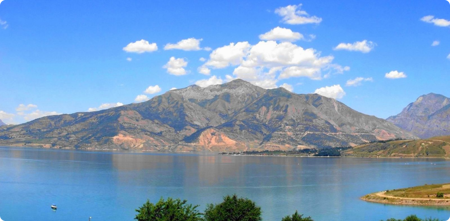The city of Samarkand is one of the oldest cities in the world, whose existence, according to scientists, appeared in the 8th century BC. The great silk road passed through Samarkand, formerly Marakand, and the city was a key point for merchants.
During the reign of Tamerlane and the Timurid dynasty, Samarkand was the capital and one of the centers of science of the medieval East. Today, there is a huge amount of medieval architecture, thanks to which we can plunge into history, seeing where people studied, lived and how the city looked a few centuries ago. The most incredible and frequently visited place in Samarkand, of course, is "Registan", but do not stop there, Samarkand will find something else to surprise you.
| Registan | |
| Registan is an ornament of Central Asia, one of the most magnificent squares in the world, which is located in the center of old Samarkand. Everyone who is lucky enough to be here can not remain indifferent: the greatness and beauty of Registan cause everyone, without exception, a sense of delight. There is a legend that from the beginning of the 15th century to the beginning of the 20th century there were public executions on the square, and that the blood was better More... | |
| Madrasah - Mirzo Ulugbek | |
| Built in the city of Samarkand in the XV century, the Mirzo Ulugbek madrassah is a revered religious building among Muslims that carries out spiritual and educational activities. The oldest religious school, founded by the ruler of the Timurid state together with the scientist astronomer Mirzo Ulugbek, is part of a magnificent architectural complex. This ensemble is located on the famous Registan square. The Ulugbek madrasa building was constructed in accordance with the Muslim rules and needs of the time. More... | |
| Madrasah - Tilla-Kori | |
| In the heart of Samarkand is a single architectural complex with the Ulugbek madrassa as well as the Sherdor madrassah, located in the Tillha-Kori madrassah, the newest building in Registan Square. The Gilded Madrasah, thus translated from the Uzbek language of Tilla-Kori, was built on the orders of the ruler of Samarkand Yalangtubia Bahadura: according to his plan, the madrassa was to complement the architectural image of Registan. The Northern part of the square was chosen as the place of construction, where in the XV century More... | |
| Madrasah - Sher Dor | |
| Sherdor madrasah, built in the seventeenth century, is part of the architectural complex of Registan square in the city of Samarkand, which belongs to the famous historical monuments of Uzbekistan. The construction of the Sherdor Muslim educational institution was carried out by decree of the Samarkand ruler Bahadur under the direction of the court architect Jabbar Abdullah. The madrasah is built on the Eastern side of Registan square. More... | |
| Mausoleum - Gur Emir | |
| One of the main historical monuments of Samarkand is the Gur-Emir tomb, which contains the remains of the great ruler and conqueror Tamerlane, as well as many members of his family. The name of this mausoleum can be translated as" ruler's tomb " or "Emir's tomb". The construction of this memorial structure began in 1403 by order of Timur himself. The reason for the construction of this building was the ruins of an ensemble of buildings that were built by Mohammed Sultan, one of the Emir's grandsons. More... | |
| Complex - Shakhi-Zinda | |
| The complex of mausoleums and tombs in Samarkand is included in the list of UNESCO cultural heritage sites. Shahi-Zinda largely reflects all the historical centuries of the city's development and is a huge religious monument. Among the local population, it bears the rather grim name "cemetery street", but in fact has no resemblance to the cemetery. Here are majestic mausoleums with the remains of rulers, relatives of Timur, thinkers and wise men, saints and philosophers. More... | |
| Ulugbek Observatory | |
| Ulugbek Observatory in Samarkand is a historical monument and one of the outstanding observatories of the middle Ages. It is not for nothing that Samarkand is called a Museum city filled with a large number of historical monuments. Since ancient times, the majestic city has been positioned as a powerful political, religious and cultural center.The history of the Observatory's creation goes back to ancient times and is inseparable from the name More... | |
| Mausoleum of Daniel (Khoja Daniyar) | |
| The mausoleum of Khoja Daniyar (Saint Daniel) is one of the most famous places of worship in Samarkand. Muslims, Christians, and Jews treat him with equal respect. Daniyar, Daniel, and Daniel are the names of a single Saint in Muslim, Christian, and Jewish literature. Samarkand historian Abu Tahirkhodja samarqandi (XVIII century) writes in his book “Samaria”: "Mazar Khodja Daniyara is located outside the city of Samarkand, at the bottom of the Northern wall of the settlement Afrasiab.More... | |
| Mausoleum - Rukhabad | |
| The most ancient, strict and ascetic building in Samarkand can be called the Rukhabad mausoleum. Here you will not find bright and colorful mosaics, outlandish finishes or glazes. The entire structure is made in a majestic but concise style. This approach is due to the fact that the relics of the revered Saint Burhaneddin Klych Sagarji, who was Tamerlane's mentor, are buried here. This mausoleum appeared in 1380 on the orders of the ruler of Central Asia. Tamerlane deeply revered Sagarji as his mentor and as a deeply religious man. More... | |
| Bibi Hanim | |
| Bibi Hanim is the largest mosque in Central Asia, which is a rather significant monument to the entire Islamic world. Only standing at the gates and majestic walls of Bibi Hanuma, you can fully feel the splendor and grandeur of this architectural complex. The way to the mosque is a massive portal, which received the mysterious name "milky way". Immediately behind it, the traveler can see the huge monumental main mosque. The history of this famous and majestic mosque in Samarkand has several variations. More... | |

| Sightseeing In Tashkent | |

| Sightseeing In Bukhara | ||
|
|
||

| Sightseeing In Fergana Valley | |

| Sightseeing In Khiva | |
|
Itchan-Kala |
|





